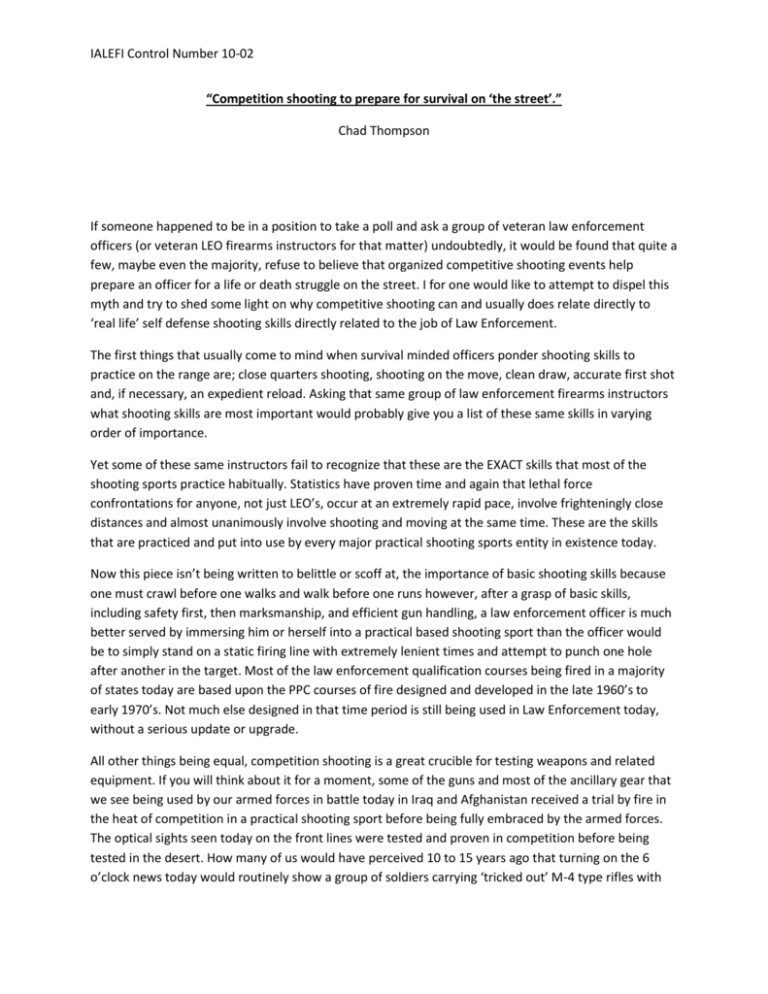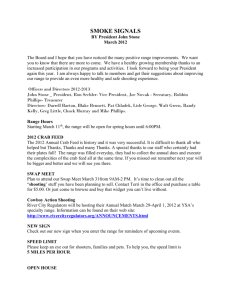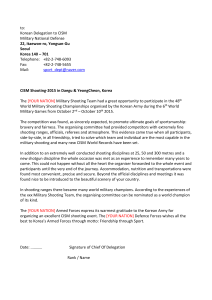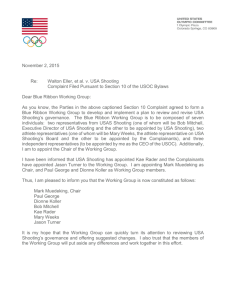“Competition shooting to prepare for survival on 'the street'
advertisement

IALEFI Control Number 10-02 “Competition shooting to prepare for survival on ‘the street’.” Chad Thompson If someone happened to be in a position to take a poll and ask a group of veteran law enforcement officers (or veteran LEO firearms instructors for that matter) undoubtedly, it would be found that quite a few, maybe even the majority, refuse to believe that organized competitive shooting events help prepare an officer for a life or death struggle on the street. I for one would like to attempt to dispel this myth and try to shed some light on why competitive shooting can and usually does relate directly to ‘real life’ self defense shooting skills directly related to the job of Law Enforcement. The first things that usually come to mind when survival minded officers ponder shooting skills to practice on the range are; close quarters shooting, shooting on the move, clean draw, accurate first shot and, if necessary, an expedient reload. Asking that same group of law enforcement firearms instructors what shooting skills are most important would probably give you a list of these same skills in varying order of importance. Yet some of these same instructors fail to recognize that these are the EXACT skills that most of the shooting sports practice habitually. Statistics have proven time and again that lethal force confrontations for anyone, not just LEO’s, occur at an extremely rapid pace, involve frighteningly close distances and almost unanimously involve shooting and moving at the same time. These are the skills that are practiced and put into use by every major practical shooting sports entity in existence today. Now this piece isn’t being written to belittle or scoff at, the importance of basic shooting skills because one must crawl before one walks and walk before one runs however, after a grasp of basic skills, including safety first, then marksmanship, and efficient gun handling, a law enforcement officer is much better served by immersing him or herself into a practical based shooting sport than the officer would be to simply stand on a static firing line with extremely lenient times and attempt to punch one hole after another in the target. Most of the law enforcement qualification courses being fired in a majority of states today are based upon the PPC courses of fire designed and developed in the late 1960’s to early 1970’s. Not much else designed in that time period is still being used in Law Enforcement today, without a serious update or upgrade. All other things being equal, competition shooting is a great crucible for testing weapons and related equipment. If you will think about it for a moment, some of the guns and most of the ancillary gear that we see being used by our armed forces in battle today in Iraq and Afghanistan received a trial by fire in the heat of competition in a practical shooting sport before being fully embraced by the armed forces. The optical sights seen today on the front lines were tested and proven in competition before being tested in the desert. How many of us would have perceived 10 to 15 years ago that turning on the 6 o’clock news today would routinely show a group of soldiers carrying ‘tricked out’ M-4 type rifles with IALEFI Control Number 10-02 red dot optics, flashlights attached and picatinny rails all around? During the rigors of any of today’s practical shooting sports, tactics and/or gear items that do not work will quickly be exposed. On that same note the weapons and related equipment that work well are seen by other competitors and usually end up being accepted and used by agencies and other organizations as well. As law enforcement firearms instructors, part of what we want to achieve on the range is a simulation of the actual stress that an officer will experience during a life or death struggle. Of course we cannot exactly duplicate that stress response without actually shooting at our officers and everyone understands that this is not the thing to do. What we can do however, is attempt to create that kind of stress in other ways. By simply placing time limits on the officer the stress begins to build. Then, the lone officer knowing that people are watching him or her perform a particular exercise is added stress as well. Forcing the officer to shoot and move and having multiple targets will cause the heart rate to rise also. Giving the officer a reactionary target with instant feedback is a great motivator. All of these things put together can help simulate the stress and physiological effects that the body will experience when forced to engage in mortal combat and these tasks are exactly what the practical shooting sports require and promote. Additionally, the safety factor of organized shooting competition is something not a lot of law enforcement firearms instructors have taken a hard look at today. While I confess that my particular competitive shooting preference is USPSA competition, I also have to say that the USPSA/IPSC organization has an unparalleled set of safety rules and regulations that are strictly enforced. To the first time casual law enforcement observer at a USPSA shooting match it could initially appear that the shooter on a stage, or a particular shooting stage itself, isn’t necessarily being conducted safely. Nothing could be farther from the truth. USPSA regulations require your handgun to be holstered with an empty magazine well and the hammer sitting forward when on the range. USPSA regulations allow NO idle handling of guns outside of the direct supervision of a Range Officer (one on one), OR in a designated and clearly marked ‘SAFETY AREA’, with absolutely no carelessness being tolerated. USPSA also goes out of their way to embrace new shooters and make them feel welcome. To date in my career I have shot hundreds of USPSA and like type matches all over the USA and several places abroad. At every one of these matches with NO EXCEPTIONS that I can recall, I have heard the Range Master during the pre-fire briefing ask if there were any shooters present who were new to this particular shooting discipline. If and when there were first time shooters at that particular match, a range officer or a squad of range officers would take that person aside after the briefing and personally and respectfully advise the new shooter of the rules and regulations pertaining to USPSA. The Range Officers at these matches genuinely wanted to make sure that the new shooter understood the rules so there would be no problems and the new shooter had a great first time shooting experience at the match. As a direct result of the ego elimination (usually) and safely emphasis I have witnessed in USPSA, I have seen absolutely NO gross safety errors or negligent discharges at any of the shooting matches where I have been present. Sadly, I cannot say the same for my time on the range with my fellow law enforcement officers, whether it was during annual qualification, basic training, or some type of agency/area competition. Often new officers aren’t properly trained from the on-set and are then IALEFI Control Number 10-02 looked down upon or berated by instructors for not knowing the correct way to perform an exercise. Some law enforcement instructors expect fellow officers (especially senior officers) to automatically know what to do and what not to do and are therefore more hesitant to correct major safety violations, sometimes resulting in accidents or incidents of negligence. Contrary to what some believe, shooting sports also emphasize accuracy above and beyond speed with a firearm. There has been a misconception in the past but it has never been true that the shooting sports reward speed above all else. Every practical shooting sport I have ever been involved with has given me the correct impression that accuracy is the final deciding factor. While the purpose of repetitive behavior is to build ‘muscle memory’ and therefore, build speed, the shooting sports realize that speed is good but accuracy is final. In closing it would be beneficial for firearms instructors to explore some of the practical shooting sports to build their own skills and to learn some new techniques to bring back to their respective agencies. Or better yet, instructors take your entire squad or agency with you to a local match. Chances are you will be hooked! (Chad Thompson is the Senior/Lead Firearms Instructor at the North Carolina Justice Academy and the School Director of the Specialized Firearms Instructor Training Course. Thompson is a 21 year Law Enforcement Veteran and is currently still sworn at a former agency. Thompson’s Law Enforcement career has been spent at various levels, from federal law enforcement to local law enforcement, and in numerous states in the US, including a year internationally as a Police Officer in Kosovo.)




